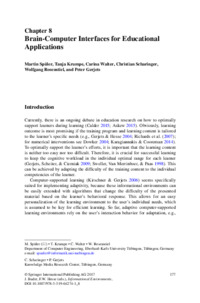Brain-Computer Interfaces for Educational ApplicationsMartin Spüler, Tanja Krumpe, Carina Walter, Christian Scharinger, Wolfgang Rosenstiel, Peter Gerjets
|
 |
 Diese Seite wurde seit 7 Jahren inhaltlich nicht mehr aktualisiert.
Unter Umständen ist sie nicht mehr aktuell.
Diese Seite wurde seit 7 Jahren inhaltlich nicht mehr aktualisiert.
Unter Umständen ist sie nicht mehr aktuell.
 Zusammenfassungen
Zusammenfassungen
 Chapter 8 (Spüler et al., 2017) reports on the use of adaptive brain-computer
interfaces in learning contexts. These interfaces try to assess the mental workload
of a learner during task performance through online measurement of brain activity
(electroencephalography). On the basis of these “neural signatures,” the system
then automatically adapts the difficulty level of arithmetic exercises to the assessed
mental workload. As these adaptations take place without the learner noticing them,
the brain-computer interfaces described in this chapter provide a nice example of
directive adaptivity.
Chapter 8 (Spüler et al., 2017) reports on the use of adaptive brain-computer
interfaces in learning contexts. These interfaces try to assess the mental workload
of a learner during task performance through online measurement of brain activity
(electroencephalography). On the basis of these “neural signatures,” the system
then automatically adapts the difficulty level of arithmetic exercises to the assessed
mental workload. As these adaptations take place without the learner noticing them,
the brain-computer interfaces described in this chapter provide a nice example of
directive adaptivity. In this chapter, we present recent developments to utilize Brain-Computer Interface (BCI) technology in an educational context. As the current workload of a learner is a crucial factor for successful learning and should be held in an optimal range, we aimed at identifying the user´s workload by recording neural signals with electroencephalography (EEG). We describe initial studies that identified potential confounds when utilizing BCIs in such a scenario. Taking into account these results, we could show in a follow-up study that EEG could successfully be used to predict workload in students solving arithmetic exercises with increasing difficulty. Based on the obtained prediction model, we developed a digital learning environment that detects the user´s workload by EEG and automatically adapts the difficulty of the presented exercises to hold the learner´s workload level in an optimal range. Beside estimating workload based on EEG recordings, we also show that different executive functions can be detected and discriminated between based on their neural signatures. These findings could be used for a more specific adaptation of complex learning environments. Based on the existing literature and the results presented in this chapter, we discuss the methodological and theoretical prospects and pitfalls of this approach and outline further possible applications of BCI technology in an educational context.
In this chapter, we present recent developments to utilize Brain-Computer Interface (BCI) technology in an educational context. As the current workload of a learner is a crucial factor for successful learning and should be held in an optimal range, we aimed at identifying the user´s workload by recording neural signals with electroencephalography (EEG). We describe initial studies that identified potential confounds when utilizing BCIs in such a scenario. Taking into account these results, we could show in a follow-up study that EEG could successfully be used to predict workload in students solving arithmetic exercises with increasing difficulty. Based on the obtained prediction model, we developed a digital learning environment that detects the user´s workload by EEG and automatically adapts the difficulty of the presented exercises to hold the learner´s workload level in an optimal range. Beside estimating workload based on EEG recordings, we also show that different executive functions can be detected and discriminated between based on their neural signatures. These findings could be used for a more specific adaptation of complex learning environments. Based on the existing literature and the results presented in this chapter, we discuss the methodological and theoretical prospects and pitfalls of this approach and outline further possible applications of BCI technology in an educational context. Dieses Kapitel erwähnt ...
Dieses Kapitel erwähnt ...
 Anderswo finden
Anderswo finden
 Volltext dieses Dokuments
Volltext dieses Dokuments
 |  Brain-Computer Interfaces for Educational Applications: Artikel als Volltext bei Springerlink ( Brain-Computer Interfaces for Educational Applications: Artikel als Volltext bei Springerlink ( : :  , 206 kByte; , 206 kByte;  : :  ) ) |
 Anderswo suchen
Anderswo suchen 
 Beat und dieses Kapitel
Beat und dieses Kapitel
Beat hat Dieses Kapitel während seiner Zeit am Institut für Medien und Schule (IMS) ins Biblionetz aufgenommen. Er hat Dieses Kapitel einmalig erfasst und bisher nicht mehr bearbeitet. Beat besitzt kein physisches, aber ein digitales Exemplar. Eine digitale Version ist auf dem Internet verfügbar (s.o.). Aufgrund der wenigen Einträge im Biblionetz scheint er es nicht wirklich gelesen zu haben. Es gibt bisher auch nur wenige Objekte im Biblionetz, die dieses Werk zitieren.











 Biblionetz-History
Biblionetz-History